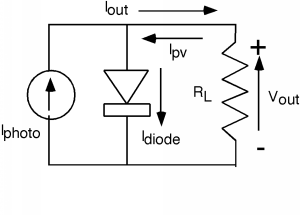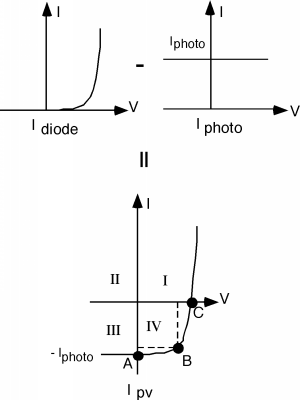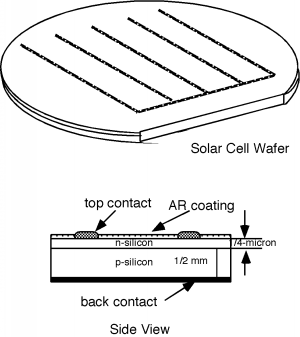| << Chapter < Page | Chapter >> Page > |
Now let us look at the opposite process of light generation for a moment. Consider the following situation where we have just a plain old normal p-n junction, only now, insteadof applying an external voltage, we imagine that the junction is being illuminated with light whose photon energy is greater thanthe band-gap ( [link] a). In this situation, instead of recombination, we will get photo-generation of electron hole pairs. The photonssimply excite electrons from the full states in the valence band, and "kick" them up into the conduction band, leaving ahole behind. This is similiar to the thermal excitation process. As can beseen from [link] b, this creates excess electrons in the conduction band in the p-side of the diode, andexcess holes in the valence band of the n-side. These carriers can diffuse over to the junction, where they will be sweptacross by the built-in electric field in the depletion region. If we were to connect the two sides of the diode together with awire, a current would flow through that wire as a result of the electrons and holes which move across the junction.

Which way would the current flow? A quick look at [link] c shows that holes (positive charge carriers) generated on the n-side will float up to thep-side as they go across the junction. Hence positive current must be coming out of the anode, or p-side of the junction.Likewise, electrons generated on the p-side will fall down the junction potential, and come out the n-side, but since they havenegative charge, this flow represents current going into the cathode. We have constructed a photovoltaic diode , or solar cell . [link] is a picture of what this would look like schematically. We might like to consider the possibility ofusing this device as a source of energy, but the way we have things set up now, since the voltage across the diode is zero,and since power equals current times voltage, we see that we are getting nada from the cell. What we need, obviously, is a loadresistor, so let's put one in. It should be clear from [link] that the photo current flowing through the load resistor will develop a voltage which it biases thediode in the forward direction, which, of course will cause current to flow back into the anode. Thiscomplicates things, it seems we have current coming out of the diode and current goinginto the diode all at the same time! How are we going to figure out what is going on?


The answer is to make a model. The current which arises due to the photon flux can be conveniently represented as a currentsource. We can leave the diode as a diode, and we have the circuit shown in [link] . Even though we show I out coming out of the device, we know by the usual polarity convention that when we defineV out as being positive at the top, then we should show the current for the photovoltaic, I pv as current going into the top, which is what was done in [link] . Note that I pv = I diode - I photo , so all we need to do is to subtract the two currents; we do this graphically in [link] . Note that we have numbered the four quadrants in the I-V plot of thetotal PV current. In quadrant I and III, the product of I and V is a positive number, meaningthat power is being dissipated in the cell. For quadrant II and IV, the product of I and V is negative, and so we are getting power from the device. Clearly wewant to operate in quadrant IV. In fact, without the addition of an external battery or current source, the circuit, willonly run in the IV'th quadrant. Consider adjusting R L , the load resistor from 0 (a short) to (an open). With R L , we would be at point A on [link] . As R L starts to increase from zero, thevoltage across both the diode and the resistor will start to increase also, and we will move to point B, say. AsR L gets bigger and bigger, we keep moving along the curve until, at point C, whereR L is an open and we have the maximum voltage across the device, but, of course, no current comingout!


Power is so at B for instance, the power coming out would be represented by the area enclosed by the two dotted lines and thecoordinate axes. Someplace about where I have point B would be where we would be getting the most power out of out solar cell.
[link] shows you what a real solar cell would look like. They are usually made from a complete wafer ofsilicon, to maximize the usable area. A shallow (0.25 μm) junction is made on the top, and top contacts are applied asstripes of metal conductor as shown. An anti-reflection (AR) coating is applied on top of that, which accounts for the bluishcolor which a typical solar cell has ( [link] ).


The solar power flux on the earth's surface is (conveniently) about 1 kW/m 2 or 100 mW/cm 2 . So if we made a solar cell from a 4 inch diameter wafer (typical) it would have an area of about and so would be receiving a flux of about 8.1 Watts. Typical cell efficiencies run from about 10% to maybe 15% unlessspecial (and costly) tricks are made. This means that we will get about 1.2 Watts out from a single wafer. Looking at B on2.59 we could guess that will be about 0.5 to 0.6 volts, thus we could expect to get maybe around 2.5 amps from a 4 inch waferat 0.5 volts with 15% efficiency under the illumination of one sun.

Notification Switch
Would you like to follow the 'Chemistry of electronic materials' conversation and receive update notifications?